Alsace with beautiful cities such as Colmar and Strasbourg always ranks among the top tourist destinations in France.
But I was born there and spent the biggest part of my life in this region and I can guarantee you that Alsace has much more to offer than these two cities, as beautiful as they are.
To fully understand the diversity of this part of France, you have to understand that schematically Alsace is composed of a massive plain in which the Rhin river flows that also marks the border with Germany and a mountain range, the Vosges.

If the flank of this mountain range with its villages and vineyards is fairly popular, the beauty of the Vosges extends far beyond them.
Like most people from Alsace, I have been countless times to the Vosges either with friends or families for hiking, visiting castles, skiing or only to enjoy a great meal in a farmhouse.
If you are planning to visit Alsace, you should not skip the Vosges and spend a day or two in nature at higher altitudes.
If you are unsure about that, let me convince you to make the trip and give you a few starting points:
1. Nature, landscapes, and views
One of the main appeals of the Vosges is its landscape and nature. Do not expect high and rocky mountain peaks like the Alps. The Vosges’ highest summit, the Grand Ballon, is only measuring at a mere 1,424 meters high.

The landscape in Vosges alternates with dense forests, rolling hills, and lush yellow/green pastures.
The southern part of the Vosges offers the most beautiful views of the Alsace Valley and Germany’s Black Forest. With clear weather, you’ll even be able to see the Alps.

The northern part of the Vosges is often considered “less beautiful” by locals like me because of its denser forest coverage that blocks the view.
What you’ll be able to appreciate in any case in the Vosges is nature and wilderness:
Most part of the mountain range is part of either the Parc naturel régional des Ballons des Vosges (one of France’s largest) or the Parc naturel régional des Vosges du Nord with some sections even recognized by UNESCO (Vosges du Nord/Pfälzerwald Transboundary Biosphere Reserve).

The Vosges are home to several protected species including wolves, lynxes, and the Western capercaillie. These elusive animals are not often seen.
More common sights are cows and goats grazing in the valleys and foothills. With some luck, you may spot more timid wildlife like chamois, deer, or even beavers.

Where to start for a great first impression of the Vosges?
If you only have a limited time and want a glimpse of what the Vosges offer, I suggest you start with the “Route des Crêtes,” also known as the Route of the Ridges.
This 89 km scenic road (closed in winter) crosses the Parc des Ballons des Vosges. Along the way, you can make several great stops:
- The Hohneck: This is the 3rd highest summit of the Vosges and an easily accessible scenic spot. It offers magnificent views overlooking the lake of Schiessrothried.

- Le col du Grand Ballon: Stopping at this mountain pass brings you just a short walk from the summit of the Grand Ballon, the highest peak in the Vosges.
- Le Markstein: Famous among locals in winter for its ski slopes, this mountain resort also offers many sports activities in summer including mountain biking, summer tobogganing, paragliding, and more.
- Hartmannswillerkopf, also known as Vieil Armand: This stop provides a completely different experience, as a major battle of World War I took place here. The French and Germans fought for control of the mountain peak for almost 11 months before France secured victory. Today, the area is a national monument where you can explore extensive trench systems and visit a museum and a cemetery.
How to visit the Route des Crêtes?
- Car: This will likely be the first option suggested when researching the route. However, confirm the road is open, as it closes in winter and some events can disrupt access (e.g. Tour de France).
- Bus: The Navette des Crêtes bus lines. Alsace, like most French regions, aims to reduce traffic impacts on protected natural areas like the Parc des Ballons Vosges. While no car ban has been implemented, some organizations have called for restricting vehicle access along the route. As an alternative, Alsace opened 9 bus lines connecting valley cities (like Colmar) to the mountains. Buses run daily in July-August and weekends in September-October. Schedule and additional details are available here: parc-ballons-vosges.fr
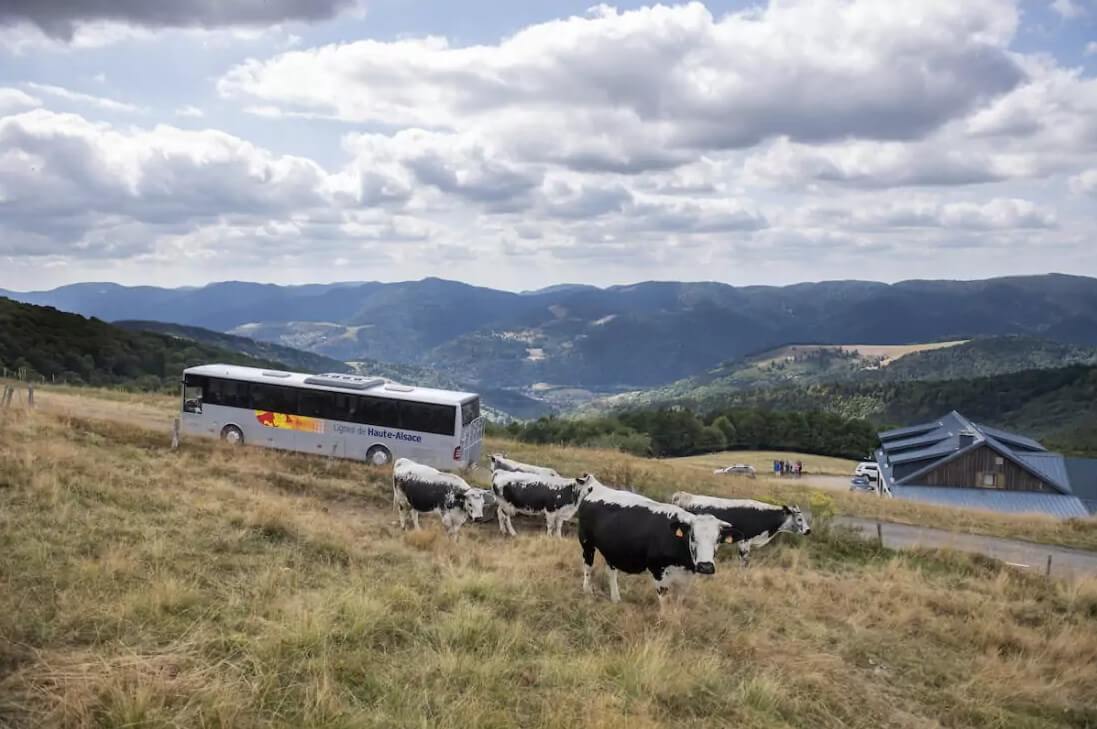
2. Hiking, mountain biking, and more…
The Vosges are a true outdoor sport paradise.
Hiking
As previously mentioned, one of the main appeals of Vosges is its natural landscapes. The best way to appreciate it is by hiking.
I cannot count the countless times when my parents pushed me as a kid or teenager to join them on hikes in the Vosges, but years later I am only grateful for that. It’s clearly the best way to appreciate this part of Alsace.
Hiking Trails in the Vosges
It’s a bit complicated to give pointers in this area as there are many factors such as your skill level, the weather/season, or simply the type of experience you are looking for.
Just to give you an idea, the AllTrails app lists over 400 different itineraries in the Vosges.

But what I can emphasize here is that you’ll always find experiences suitable for you:
- For hikes that will take you to lakes, you can swim in during hot summer days, look for routes starting or ending at Kruth-Wildenstein Lake or Lake Gerardmer.
- For hikes allowing you to see old castles and taste the wines that Alsace is famous for, head to Ribeauville for its Three Castles Hike.
- For a true Alpine mountain experience, the famous “Sentier des Roches” is ideal. This dramatic loop trail is partly carved into the mountainside, with a ladder, tunnel, and sheer drops. I’d recommend it only for experienced hikers.
- For a multi-day trek, try following one of the GR routes. The Grande Randonnée (French for “long-distance hike”) is a famous European network of long-distance footpaths. Several traverse the Vosges (GR5, GR53, GR531, GR532, GR533). These GRs are renowned across Europe, so you’ll find extensive documentation if you want to hike a section.
Mountain Biking, Paragliding, and More…
Of course, hiking is only one way to enjoy sports in the Vosges.
The Vosges are also renowned for:
- Cycling: Its multiple mountain passes have made the Vosges a popular destination for cyclists. The Tour de France has stopped there several times, and the Vosges’ slopes are more accessible than the Alps’ ones.

- Mountain biking: The Vosges has everything needed for great mountain biking – beautiful vast forests, a superb network of singletrack trails, and panoramic viewpoints over the surrounding mountains.
- Paragliding: How about a bird’s eye view? The Vosges has several sites for paragliding flights. Contrary to some beliefs, it’s not an extreme sport. For instance, you can book an introductory tandem flight with an experienced instructor from Markstein or Gérardmer.
- Running: If you’re a competitor, you’ll be glad to know the Vosges hosts various races, from ultratrails (L’Infernal Trail des Vosges) to marathon-distance (Les Crêtes Vosgiennes) to shorter distances…
3. Altitude Gastronomy – Eating in the Vosges
Alsace’s gastronomy is famous and for good reason. It has a very distinctive identity that you won’t find anywhere else in France. This is something I will cover in more detail in upcoming articles.
What you have to also know is that the Vosges mountains have their own culinary traditions, distinct from what you may experience in Alsace plain.
Here is what you should try before going down to the valley while you are still in the mountains.
Ferme Auberges
Ferme auberges in the Vosges evolved from the region’s marcairies – small mountain farms where cattle were taken to graze during the summer months. At these secluded farms called marcairies, farmers produced Munster cheese. In the late 1800s, they began welcoming hikers, botanists, and travelers, offering them rustic meals and lodging.

This early form of farm stays grew as the Club Vosgien hiking club formed in 1872. Modern ferme auberges continue this tradition, with Vosges farmers opening their mountain farms as both inns and restaurants.
Guests can lodge in the farmhouses (but most head down to the valley before day’s end), dine on cheeses, fruits, vegetables, and meats produced on-site, and experience authentic Vosges hospitality and cuisine.
What will you eat in Ferme Auberges?
In Ferme Auberges the menu is limited, as dishes depend on the farm’s production. Remember, Ferme Auberges are not restaurants, they are an extension of the farm’s activities.
The famous Mercaire menu: This is what you are most likely to find. It consists of soup or meat pie (for a starter), smoked pork accompanied by “roïgabrageldi” (sliced potatoes cooked 2-3 hours in farm butter with onions and bacon), Munster cheese (or Bargkas) and/or dessert (farmhouse fromage blanc drizzled with kirsch or homemade tart).
Below a meal we had the chance to enjoy at the Ferme Auberge du Kastelberg:
Starter:
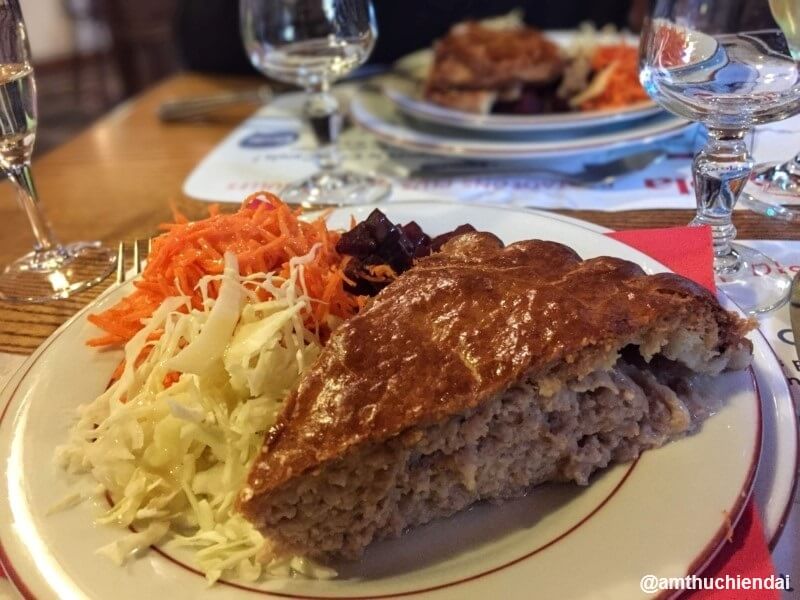
Main course:

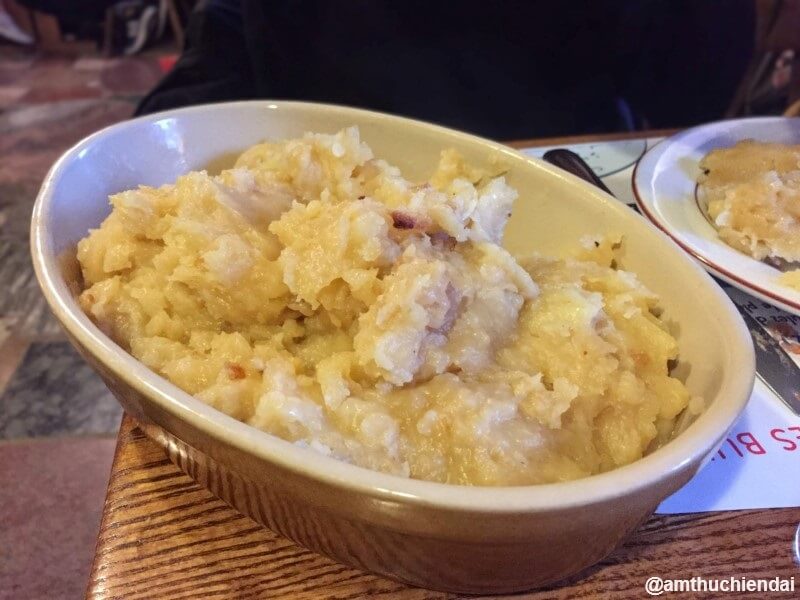
Dessert:
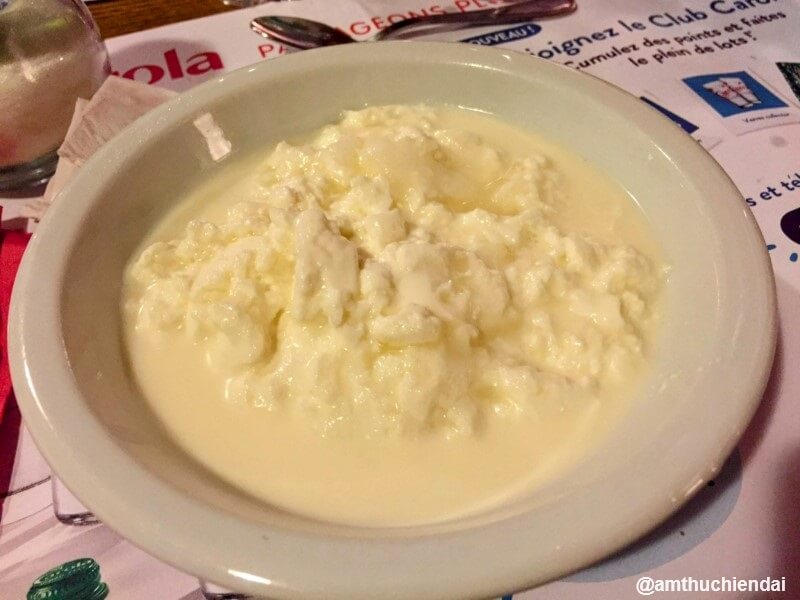
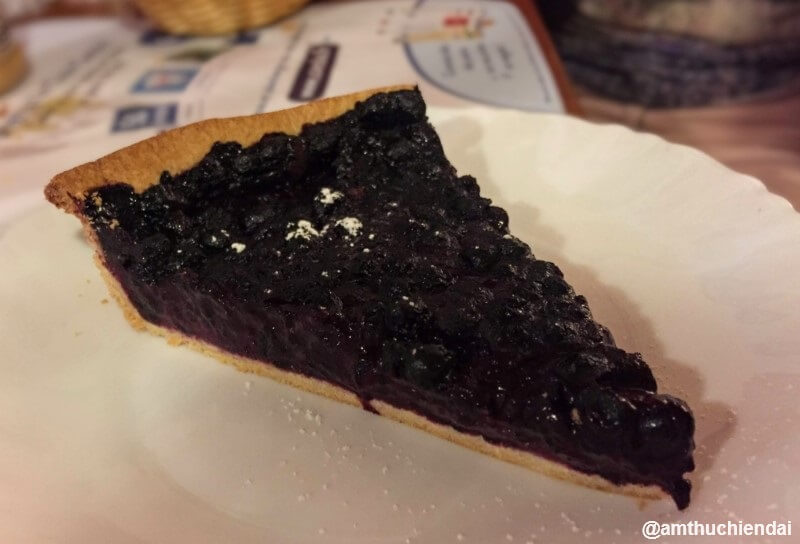
Cochonailles
The term “cochonailles” refers to large multi-course pork feasts served up on autumn weekends at these farmhouse inns. These meals feature plenty of charcuterie and pork dishes prepared from pigs fed and fattened all spring and summer for fall. Be aware, that seats at these feasts fill up quickly, so reservations are recommended if you want to join.
Cheese
France has so many unique and incredible cheeses to offer, especially in its mountainous regions. Vosges is no exception.
Munster
If one cheese represents Vosges in the valleys, it is Munster. This soft-washed rind cheese is made exclusively from the rich milk of cows grazing the verdant Vosges mountains. Don’t be alarmed by its very strong smell, as each bite of Munster reveals an unexpected mildness and complexity.

Produced in Alsace since medieval times, authentic Munster carries the AOC label certifying its Vosges Valley origin.
In Alsace, we enjoy eating it with bread (like most cheeses) but also melted or grated and served with potatoes (a traditional winter dish).
Other Cheeses
Farmers in the Vosges also produce other cheeses:
Bargkass is a raw milk cheese with a pressed curd traditionally produced in the Vosges. It is made in spring, early summer, and fall when animals graze on pastures and produce abundant milk.
Goat Cheese: Several farms now raise goats, allowing them to make great artisanal cheeses.
4. Winter Sports in the Vosges
Every winter, the Vosges region is blanketed in snow for several weeks, providing a unique experience for nature enthusiasts and sports lovers.

Ski Resorts
The Vosges is home to more than a dozen family-friendly ski resorts that usually operate from December to March.
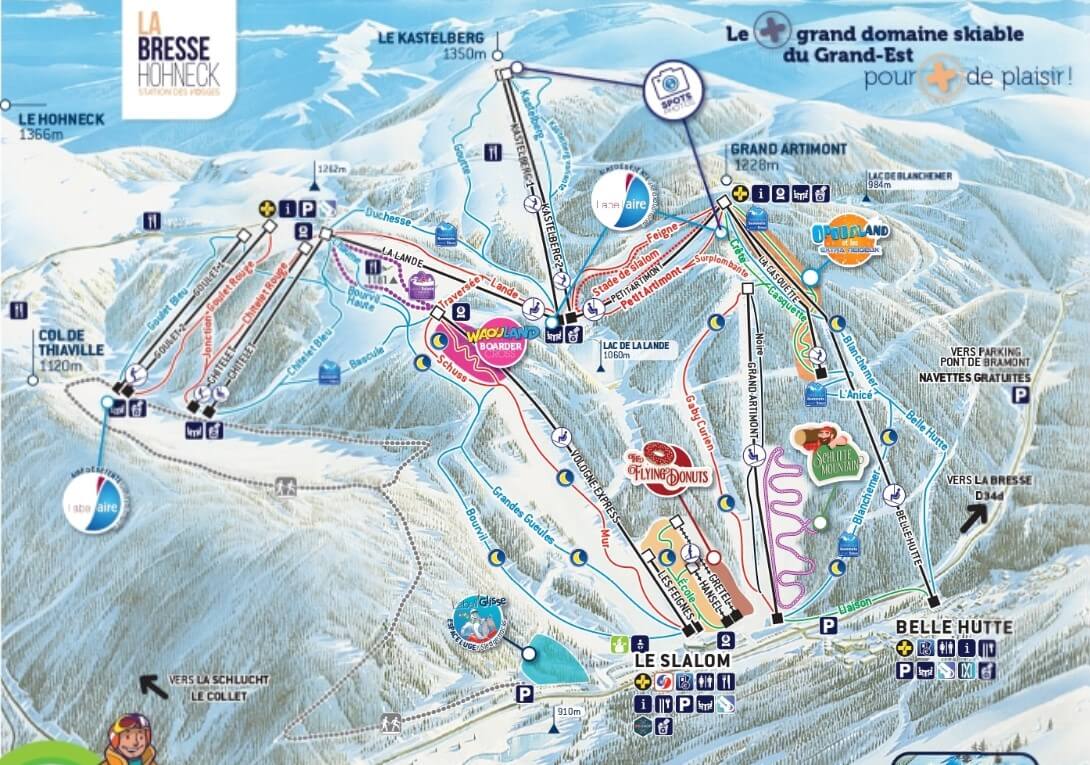
The most renowned resorts that I used to frequent include:
- La Bresse Hohneck ( Vosges’ largest ski resort)
- Gérardmer
- Lac Blanc
- Schnepfenried
- Grand Ballon
- Le Markstein
However, it’s important to consider a few factors before planning a ski trip from a distance:
- These resorts are notably smaller compared to those in the Alps. Even the largest ski resort, La Bresse, can’t compete with medium-sized Alpine resorts in terms of size.
- Snow coverage can be a concern, even with the use of snow cannons. Due to global warming, smaller stations located below 1000 meters may face extended periods without snow during winters. Nevertheless, the appeal of the Vosges ski stations remains strong.
Nordic Skiing and Snowshoeing
Nordic skiing has been extremely popular in the Vosges for many years.

Most of the major resorts mentioned earlier offer dedicated Nordic skiing tracks. I’d like to add one specific name to the list: Le Champ du Feu which has some of the largest terrain in the Vosges specifically for this sport.
Snowshoeing has also been gaining traction in the Vosges. There are many designated snowshoeing trails to choose from and it’s easy to rent equipment at any of the local ski resorts.
Preparing for a Less Snowy Future?
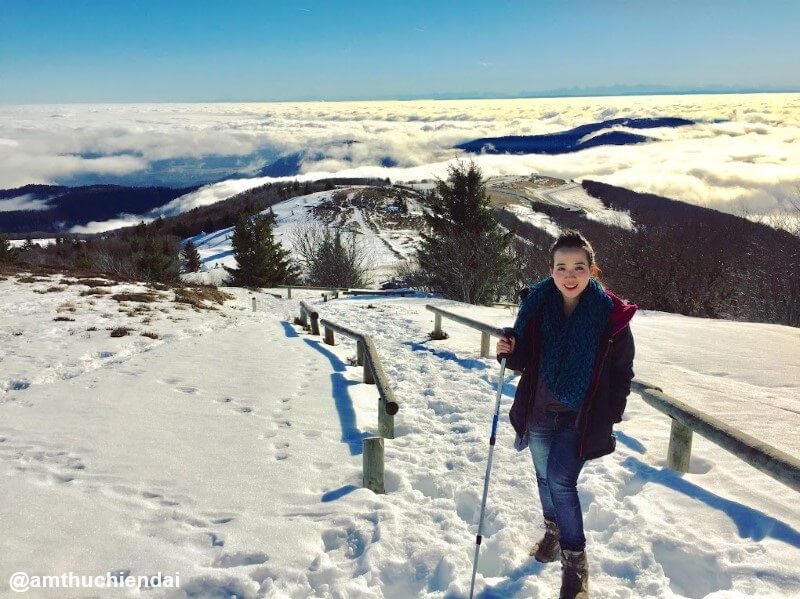
All forecasts indicate the same reality—snowfalls in the Vosges will become scarcer due to global warming. This is not a mere theory or a speculative notion; it is a fact that local authorities are actively preparing for.
In practice, this means that the most prominent winter sports destinations are gradually expanding their offerings to cater to winters with less snow. So, don’t cancel your vacation plans too hastily if snow is missing.
5. Vosges (and Alsace) Castles
Alsace’s history is a complex one, and one legacy of this is the multitude of castles that were used to control the area.
Over 500 castles were built in Alsace between the 10th and 14th centuries. Today, approximately 150 are still visible, in various states of preservation, and are mostly located on the crest or flanks of the Vosges mountain range.
You might be interested to know that a Castle Road exists, allowing hikers to traverse a path passing more than 80 castles over 450 km.
But it’s very unlikely that you’ll have time for all of that, so I will give you a shortlist of notable castles in Alsace worth seeing.
Haut-Koenigsbourg (Bas-Rhin)

If you’re in the Vosges and can only see one castle, Haut-Koenigsbourg is a must-see. It’s historically significant, with medieval architecture and furnishings.
The early 20th-century renovation, commissioned by Kaiser Wilhelm II, was designed to reflect its 15th-century condition. Despite some criticism, the restoration offers a true medieval experience, with as a bonus a view over the Alsace valley.
Many children in Alsace, myself included, visited it during school trips. Years later, it’s still the castle that comes to my mind when thinking about medieval fortresses.
Fleckenstein Castle (Bas-Rhin)

Located at the extreme northern end of the Vosges mountain range, near the German border, Fleckenstein Castle is a site worth visiting. Perched on a rocky outcrop, it stands as a prime example of a medieval fortress. Constructed in the 12th century, Fleckenstein was recognized for its strategic significance and formidable defenses. Its unique feature is its integration with the surrounding natural rock formations, giving it an imposing and rugged appearance.
The Three Castles of Ribeauvillé (Haut-Rhin)
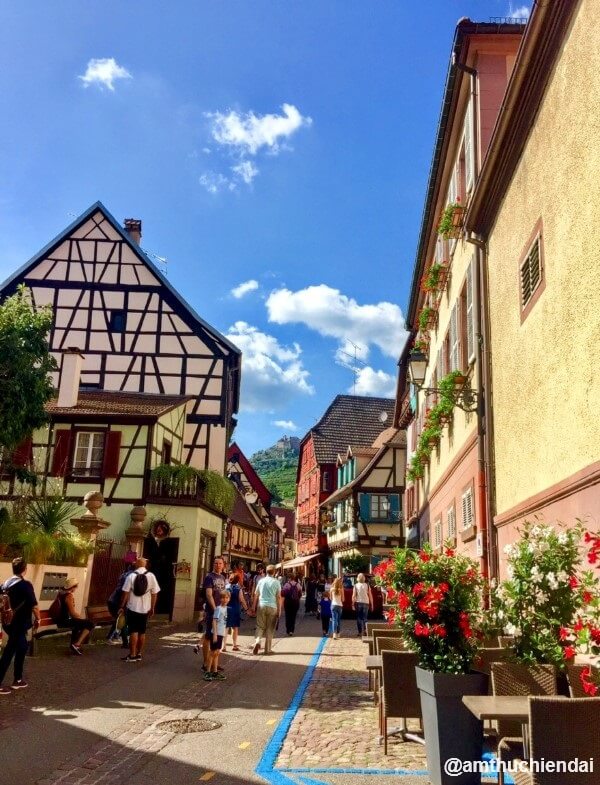
The three castles of Ribeauvillé in the Vosges – Saint-Ulrich, Girsberg, and Haut-Ribeaupierre – offer not only insights into medieval fortifications but also complement a visit to Ribeauvillé, one of the most charming villages in Alsace. Each castle, showcasing different aspects of medieval architecture, stands at varying elevations and is mostly in ruins. Saint-Ulrich, the largest, blends Romanesque and Gothic styles. Girsberg, though smaller, is well-preserved, and Haut-Ribeaupierre, largely a ruin, offers stunning views.
I suggest exploring these castles and then visiting Ribeauvillé and its nearby vineyards for an excellent combination of culture, history, and local gastronomy.
If you’re interested in a similar mix of vineyards, castles, and picturesque villages, you can also consider Éguisheim, which ranks among the most beautiful villages in France and is as well known for its three castles.
Ortenbourg and Ramstein (Bas-Rhin)
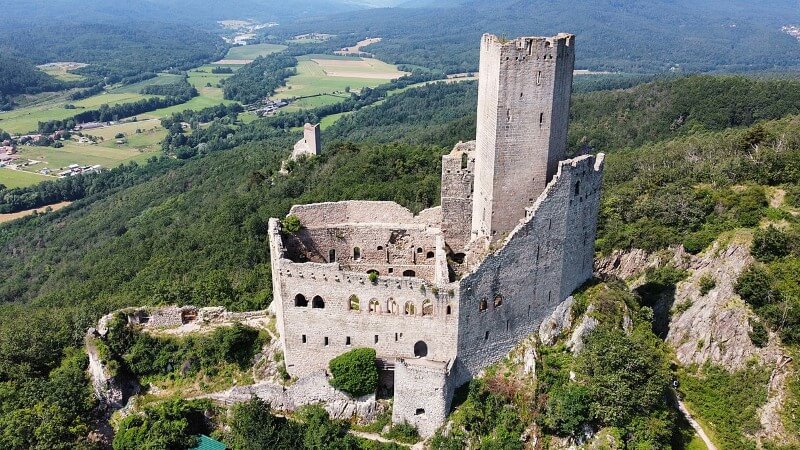
The Ortenbourg and Ramstein castles, dominating the commune of Scherwiller in the Bas-Rhin department, are two other historical landmarks nestled in the Vosges foothills near Sélestat.
L’Ortenbourg, towering at 437 meters, is recognized as a historical monument and is notable for its military architecture, featuring a pentagonal keep and a seigneurial 35-meter high dwelling with Gothic windows.
Ramstein Castle, probably built by Otto IV of Ochsenstein at the end of the 13th century, lies about 200 meters southwest of l’Ortenbourg. Its notable remains include an imposing residential tower, though only parts of its north and eastern walls survive.
Both castles were classified as historical monuments in 1924, and since 2002, volunteer efforts have been crucial in maintaining Ramstein’s remnants.
Hohlandsbourg Castle (Haut-Rhin)
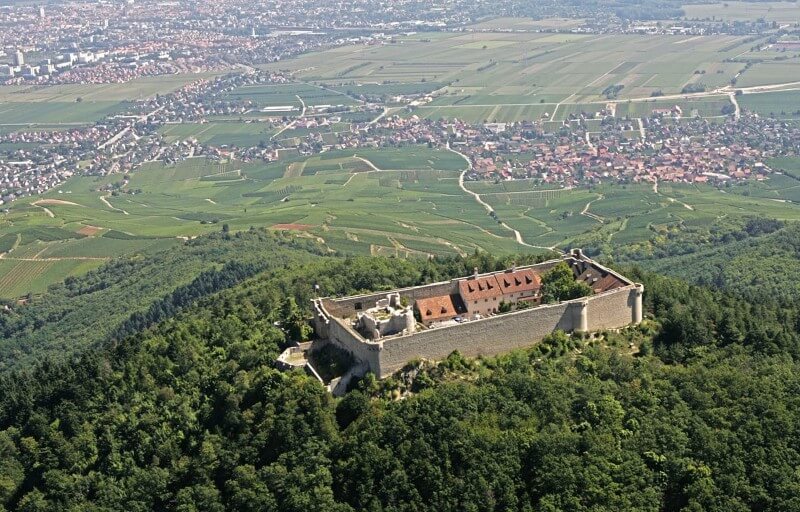
A last recommendation: if you’re near Colmar and interested in history, consider visiting Château du Hohlandsbourg.
Just a short drive away, this castle in Haut-Rhin dates back to 1279, built by Sigfrid de Gundolsheim. At 640 meters, its strategic location provides extensive views over Colmar and the whole Alsace plain. Comprising the ancient Oberschloss (upper castle) and a vast courtyard, the castle’s granite structure was declared a historical monument in 1840.
Renovations since 1986 have aimed to make it a key tourist destination. Its proximity to Colmar and the variety of activities and events hosted there add to its appeal.
6. Lakes
Do you like enjoying outdoor activities but need more than hiking trails? What about lakes? The Vosges landscape is dotted with lakes nestled in its valleys or plateaus.
This is another experience that this part of France can offer that I have enjoyed a lot during my youth. Yes, swimming is more fun than hiking when you are twelve years old.
Just be aware of two things:
These are mountain lakes, which means that except in summer, you won’t be able to swim. During summer, the water temperature will remain relatively cool—22 to 24 degrees Celsius at best.
The fact that you’ll find dozens (hundreds?) of lakes in the Vosges does not mean that you’ll be able to swim in all of them. Some of them are strictly used for electricity production, some are home to unique protected ecosystems, and some are located at altitudes over 1,000 meters, making them too cold to swim in year-round.
This does not mean they are not worth seeing—fishing and hiking are widespread activities around the most “remote” lakes, not to mention the wilderness surrounding them.
If you want a few names of the largest lakes in the Vosges that offer a wide range of activities, including swimming, here’s what locals like me would recommend:
Gérardmer Lake (Vosges)
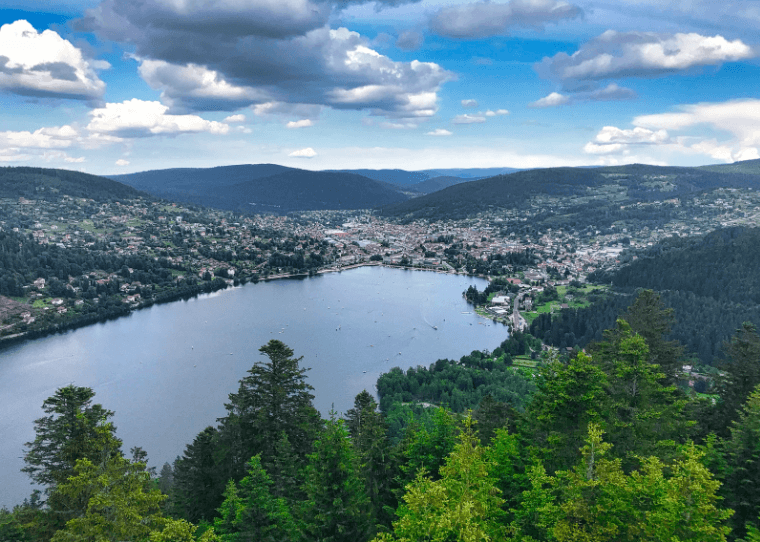
Located next to the tourist town of Gérardmer, Lac de Gérardmer formed during the glacial period. As the largest lake in the Vosges, it’s a paradise for fishermen, teeming with pike. The lake also offers a variety of water activities, including pedal boating, diving, and water skiing. Additionally, a popular hiking trail runs along the lake’s edge, adding to its charm and appeal for visitors. This would be my personal recommendation if you want to enjoy nautical activities but also have access to all the services and activities that a tourist hub like Gérardmer can offer.
Longemer Lake (Vosges)
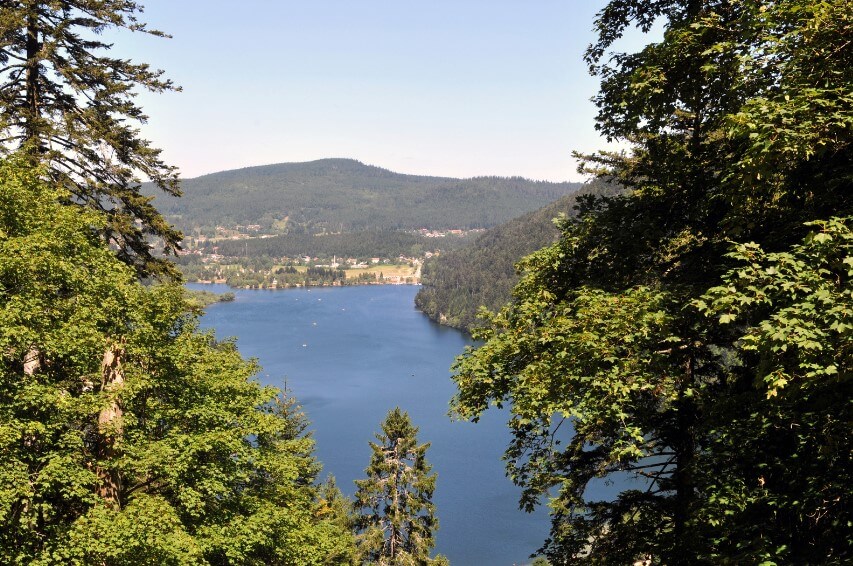
Nicknamed the “Lake of a Thousand Reflections,” Lac de Longemer is another key tourist spot in the region. Compared to its neighbor Gérardmer, Longemer is reputed to be wilder. Nestled in a classified site, the lake is surrounded by beautiful forests, best enjoyed by following the pedestrian trail that circles the lake for about an hour. Swimming and fishing are also popular activities here, and pedal boats are available. The lake is also an ideal spot for those interested in trying their hand at fly fishing.
Kruth – Wildenstein (Haut-Rhin)
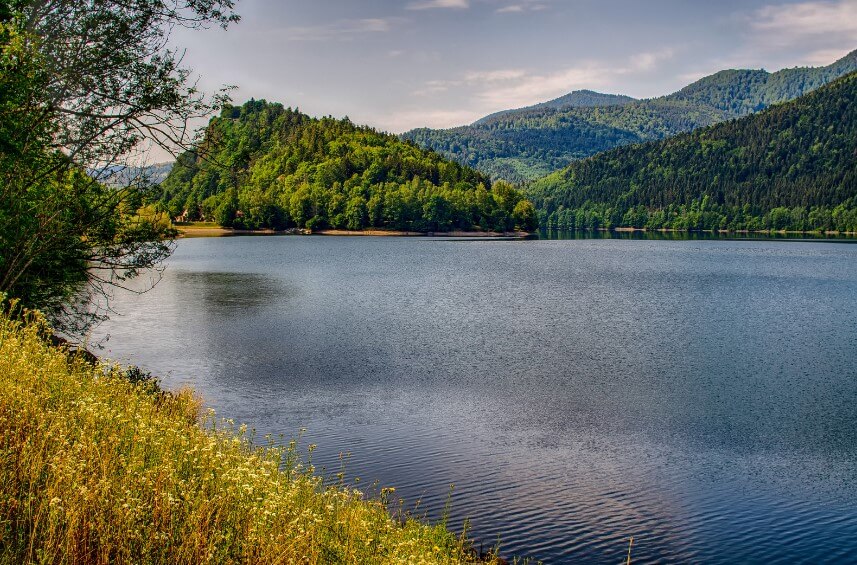
If you are looking for more options on the southern side of Alsace with relatively easy access from Mulhouse, then the Kruth Wildenstein lake should be your pick. This artificial lake created by a dam on the Thur River covers an area of over 81 hectares.
It’s a hub for activities like fishing, canoeing, diving, and pedal boating, making it a popular spot during summer. You’ll also find the ruins of Wildenstein Castle, the Bockloch waterfall, and a climbing site with 28 routes in the immediate vicinity. As someone born in Mulhouse, it’s the lake I have visited by far the most.
This is not it…
I have selected these three lakes for their size, popularity, and facilities. As previously mentioned, dozens of other lakes are scattered across the Vosges mountain range.
Compared to the 3 lakes mentioned previously, most of these mountain lakes do not have specific facilities for swimming (it’s even strictly prohibited in many of them).
That does not mean they have nothing to offer. If you need additional examples to be convinced :
- Lac Noir, Lac Blanc, and Lac des Truites (Trout Lake) for example are all located relatively close to each other at an altitude of approximately 1,000 meters, while each retains a very distinctive identity. A great feature is that all three lakes can be connected by an accessible 11km hike named the Three Lakes trail.

- Lispach Lake also offers a unique experience sought after by botanists as it is surrounded by a bog home to rare species such as carnivorous plants…
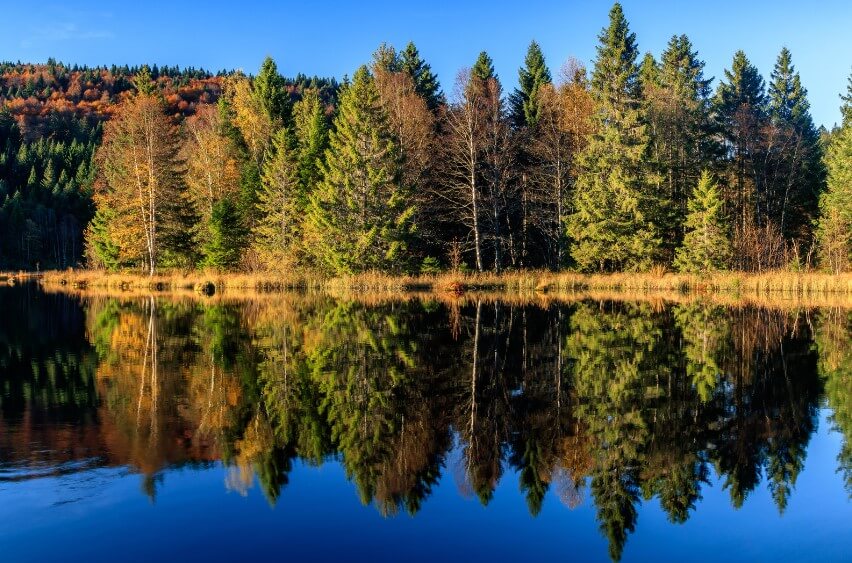
This piece is part of our extensive coverage of Europe and its culture, especially culinary one. As I am originally from Alsace, you can expect more articles highlighting this specific region of France.

